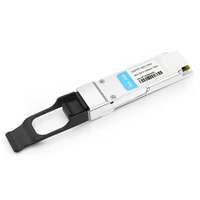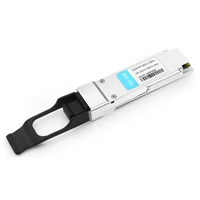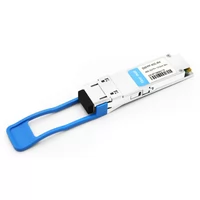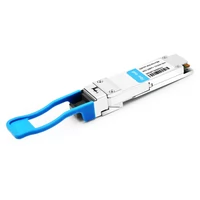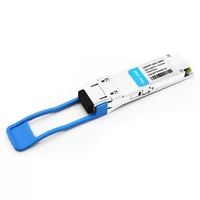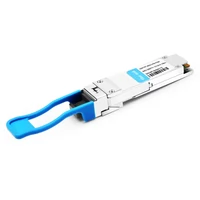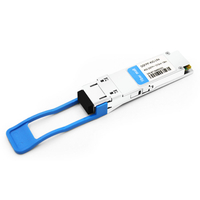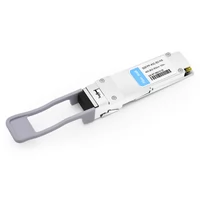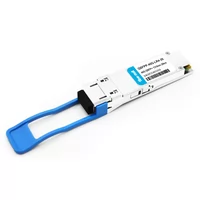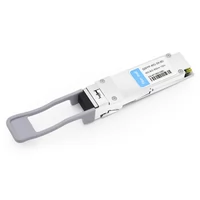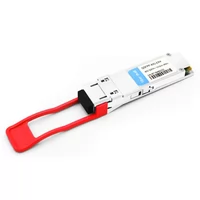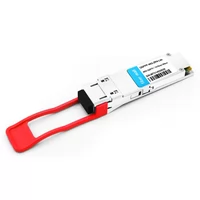In the rapidly changing field of networking technology, the Cisco QSFP 40G transceiver module is an important part that enables fast data transfer and dependable connections. This article will give you a full view of the QSFP 40G, including its technical specifications, benefits for operation, and possible uses in different network architectures. The readers will understand how it’s designed, the significance of the form factor used by it, and its optimum utilization at data centers. This guidebook should be read by all those who are involved in IT or work as a Network Engineer since they will find it helpful to know more about Cisco’s QSFAP-40G Transceiver Module, which is used widely in modern-day solutions concerning networking.
Table of Contents
ToggleWhat is the Cisco QSFP 40G transceiver module?
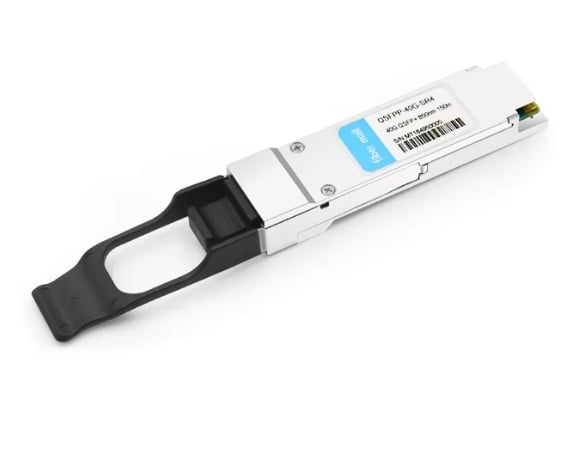
Overview of the Cisco QSFP-40G-SR4
The Cisco QSFP-40G-SR4 is a quad-small form-factor pluggable transceiver designed for high-speed data communication and optimized for data center applications. Using an Ethernet protocol, it supports a rate of 40 Gbps over multimode fiber. The transceiver works on 850 nm wavelengths and employs four transmission and reception lanes, improving bandwidth utilization. It complies with the IEEE 802.3bm standard, enabling it to be used in both short-range and long-range applications within 100m of OM3 cables and up to 150m in OM4 cables. Furthermore, its energy-efficient design ensures lower power consumption, which contributes to overall operational efficiency in network infrastructure.
Technical specifications and features
The Cisco QSFP-40G-SR4 transceiver module has various critical specifications and features that contribute to its high performance in network environments.
- Data Rate: It provides a 40 Gbps throughput for fast data transfer, which is crucial for cloud and data center operations.
- Transmission Distance: It can send data over multimode fiber up to 100 meters with OM3 cables and even more, up to 150 meters when using OM4 cables, making it usable across different setups.
- Wavelength: This device uses 850 nm, which best suits short-range applications in modern data centers.
- Form Factor: The equipment uses a quad small form-factor pluggable (QSFP) to ensure quick interchangeability without taking many times during repairs or maintenance.
- Lane Configuration: Four lanes are employed for signal transmission and reception, increasing bandwidth efficiency while decreasing latency.
- Standards Compliance: This product follows IEEE 802.3bm standard, thus ensuring compatibility among various networking devices and enhancing their cooperation ability.
- Power Consumption: It works efficiently regarding energy consumption, hence minimizing operational costs due to optimal usage of power without compromising performance level.
These technical specifications make the Cisco QSFP-40G-SR4 an essential component in high-performance, scalable network architectures.
Common use cases in modern networks
The Cisco QSFP-40G-SR4 transceiver module is a versatile and high-performance component used in many modern networking scenarios. Some of its primary applications include:
- Data Centers: This module is perfect for data center interconnects, providing fast connections between servers, switches, and other devices. It allows rapid data transfers, which are important for cloud computing and processing large amounts of information.
- High-Performance Computing (HPC): In situations where power and speed are critical the QSFP-40G-SR4 can be used to allow quick communication between nodes thereby improving overall performance as well as computation speeds.
- Telecommunications: Routers and switches in telecommunications networks use this device so that short distance data transmission can occur with low latency thus ensuring service quality within telecom operations.
The above examples demonstrate how important Cisco’s QSFP-40G-SR4 is when it comes to meeting current network infrastructure needs by facilitating efficient exchange of information.
How Does the Cisco QSFP-40G-SR4 optical transceiver Work?
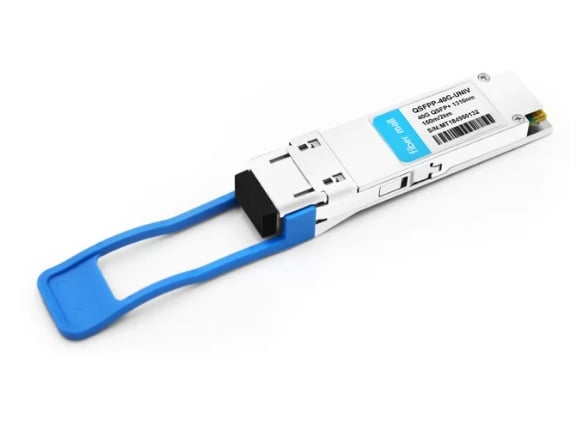
Basic working principles
Cisco QSFP-40G-SR4 works simply by transmitting light through multimode optical fibers. It takes electrical signals and turns them into optical ones for sending out, then does the opposite when receiving. The transceiver uses four parallel optical paths that can each provide 10 Gbps data rate, resulting in a total of 40 Gbps bandwidth. This is done with lasers and photodetectors to encode and decode information efficiently. Accurate alignment and calibration maintain the integrity of the optical signal to ensure minimal loss as it travels through the fiber medium.
The role of MMF and DOM
The Cisco QSFP-40G-SR4 transceiver works better because of MultiMode Fiber (MMF) and Digital Optical Monitoring (DOM).
MultiMode Fiber (MMF)
High-speed data transfer over short distances relies heavily on multi-mode fiber (MMF). MMFs have larger cores, usually measuring 50 or 62.5 microns in diameter, enabling them to carry many light modes at once which increases their bandwidth. For the QSFP-40G-SR4, this is especially helpful for data centers and enterprise networks where the distance does not exceed 150 meters. Single-mode fiber is more expensive than multimode fiber; therefore, it’s a great choice for projects that require high throughput but are on a budget.
Digital Optical Monitoring (DOM)
In real-time, Digital Optical Monitoring (DOM) identifies issues with how well the transceiver is working. This allows network administrators to check if everything is working properly by providing information such as optical power levels, temperature, and bias current, among other things, which helps them keep an eye on if there could be any changes happening soon enough so they can fix them before anything major happens like transmission failure thus making sure their job runs smoothly without hiccups every now then when something goes wrong due lack of maintenance work done earlier on the equipment used within their organization’s infrastructure thus improving overall reliability since people don’t want things breaking down constantly around here.
Together these two technologies make up what makes a KSFP-40G SR4 good at its job they help ensure strong communication between machines while allowing us monitor performance across networks we manage.
Compatibility with other Cisco modules
This transceiver is compatible with a variety of Cisco modules for versatile network setups. It is important to mention that this module supports the Cisco Nexus 9000 series switches, which are meant for high-density data center environments. Furthermore, it works perfectly well with the Catalyst 9000 series, thus ensuring smooth integration in enterprise networks. The QSFP-40G-SR4 can be used on SFP+ interfaces as long as its specifications are supported by your router or switch, and so should they be supported by routers/switches equipped to use them – allowing administrators easier time integrating into existing infrastructure’s optimal transfer speeds while enhancing scalability/adaptability across wider areas.
Why Choose the Cisco QSFP-40G-SR4 for Your Network?
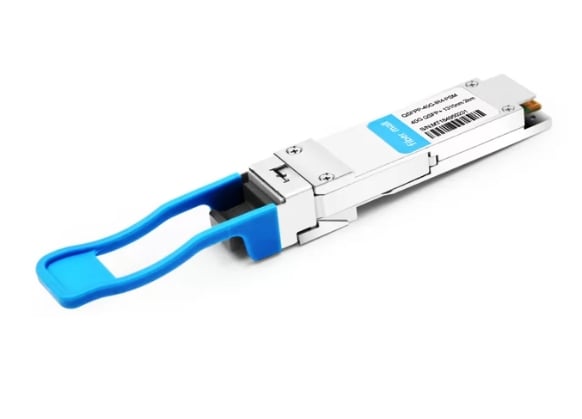
Advantages over other transceivers
The Cisco QSFP-40G-SR4 transceiver is better than other transceivers available in the market because it has fantastic performance, reliability and scalability.
- Fast Data Rates: The device operates at a 40 Gbps data rate using four independent channels, each of which supports 10 Gbps. The use of this configuration facilitates efficient transmission over multi-mode fiber cables, which makes it suitable for high-bandwidth applications within data centers.
- Optimized Reach: This equipment can transmit a signal up to a distance of about 150 meters on OM3 multimode fiber while the maximum distance that can be covered by OM4 is 400m. It guarantees minimal loss and high fidelity over long distances making it appropriate for short-range communication.
- Improved Thermal Performance: It features advanced heat management techniques to improve its operational efficiency as well as elongate its lifespan hence ensuring consistent operation amidst different environmental conditions critical for network stability.
- Low Power Usage: With approximately three point five watts power consumption, this device uses less energy compared to other competing transceivers, thus lowering operational costs and promoting sustainable business practices.
- Multi-source Agreement (MSA) Compliance: By conforming with MSA standards, this item supports interoperability between itself and third-party devices, ensuring flexibility in network design without compromising performance quality.
- Advanced Diagnostics: The QSFP-40G-SR4 includes Digital Optical Monitoring (DOM) capabilities, which allow detailed monitoring of optical power levels, temperature, and functionality of the transceiver. This helps network administrators take preventive measures against potential problems and increases operational reliability.
- Robust Integration: Ease of deployment is guaranteed through compatibility with various Cisco platforms and systems from other vendors, thus facilitating smooth transitions when upgrading existing networks to higher bandwidth solutions.
In conclusion, The Cisco QSFP-40G-SR4 Transceiver stands out due to its high-performance level coupled with energy efficiency features plus strong diagnostic abilities, making it an ideal choice for companies seeking improvement in their infrastructure development projects.
Performance in high-density applications
The Cisco QSFP-40G-SR4 transceiver is designed specifically for high-density applications where space and bandwidth are limited. This compact form factor allows data centers to maximize rack space usage and increase port density without compromising on connectivity options. With a 40 Gbps capacity over multimode fiber, the QSFP-40G-SR4 can rapidly transmit data between devices in support of modern bandwidth-hungry services such as cloud computing, big data analytics or video streaming. In addition, its low latency feature enhances network responsiveness which is vital for maintaining seamless interaction among numerous users in densely populated environments.
Reliability and durability
Reliability and durability are the most critical factors for Cisco QSFP-40G-SR4 transceivers, especially when working in harsh environments where network performance must be consistent. This device is made of high-quality materials with innovative technology that complies with industry standards regarding thermal and mechanical resistance. Its sturdy design can withstand environmental changes like dust accumulation or temperature variability, which can negatively affect its functionality. In addition, it goes through rigorous testing to ensure it works properly, even under extreme conditions. To promote this reliability, the company offers long-lasting warranties as well as extensive support to help businesses maintain their networks at peak performance over time.
How do you install and connect the Cisco QSFP 40G optical transceiver?
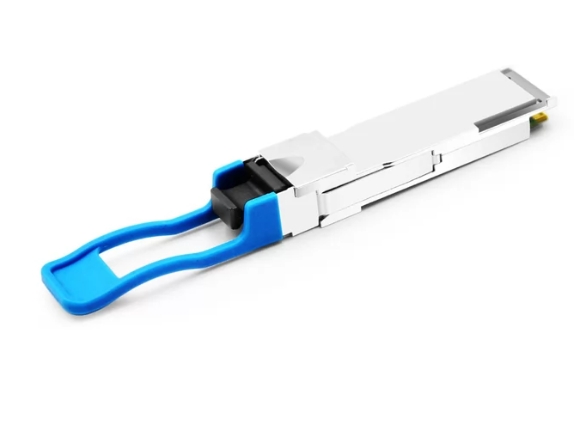
Step-by-step installation guide
- Preparation: Turn off the network equipment to avoid any electrical hazards.
- Identify Port: Find the right QSFP port on the switch or router to set up the transceiver.
- Inspect Transceiver: Ascertain that Cisco QSFP-40G-SR4 is clean and there is no damage on it.
- Insert Transceiver: Take a transceiver, align its connector with that of a port, and insert it by clicking.
- Connect Fiber Cable: Ensure you have firmly connected multimode fiber cable to the transceiver.
- Power On Equipment: After properly installing, turn on all devices in your network system/switches/computer servers, etc., including brand new routers, switches, or firewalls.
- Check Connectivity: Use relevant network monitoring tools to affirm the correct functioning of the transceiver and an established link.
Connecting with LC connectors and other interfaces
Because of their small size and ability to work well, LC connectors are often used in applications where there is a lot of density. Here are the instructions for connecting LC connectors to Cisco’s QSFP-40G-SR4 transceiver:
- Choose Compatible Cables: Choose multimode fiber optic cables with LC connectors. Make sure that the cable length is suitable for the desired connection distance.
- Adapter Utilization: Use an LC to SC adapter or patch cable if it is not possible to connect directly.
- Secure Connection: To avoid signal loss, ensure firm attachment of LC connectors on transceiver ports as they should be fully seated and locked into place.
- Testing: After making connections, run a link test using diagnostic tools which will help verify whether or not the transceiver has been linked correctly and data transmission works as expected.
Organizations can use these guidelines so that they can effectively employ LC connectors with their Cisco qsfp 40g optical transceivers, thus ensuring optimal network performance and reliability.
Troubleshooting common issues
Several common problems can occur with Cisco QSFP-40G-SR4 transceivers and LC connections. Here are some important troubleshooting steps from reputable sources:
No Link Detected: When the transceiver seems to be installed correctly, but there is no link detected, check:
- Make sure both ends of the fiber optic cable are correctly connected and locked in place.
- Ensure that you are using the correct type of multimode fiber optic cable. Using single-mode cables may result in a failed connection.
- Look for any physical damage or dirt on the SFP transceiver’s connectors, which could block light transmission.
Intermittent Connectivity: In cases where connections drop out intermittently:
- Check for bends or kinks in your fiber optic cable that might interfere with signal paths.
- Use a visual fault locator to test for breaks or faults within the fiber.
- Check the settings on your connected network equipment to make sure they’re compatible with the specifications for this type of transceiver.
Poor Performance: If you have established a link but it’s performing poorly:
- Use network management software to monitor link quality metrics such as packet loss and latency.
- The transceiver firmware should be updated to the latest version since updates can improve the performance and compatibility of devices.
- Distance and quality should also be considered when evaluating optical fibers; excessive lengths may cause degradation in signals beyond specification limits.
When applied alongside other diagnostic tools in networking environments these strategies will usually fix issues quickly allowing Cisco QSFP – 40G -SR4/LC connections work stably again.
What Are the Key Features of the Cisco QSFP-40G-SR4 optical transceiver module?
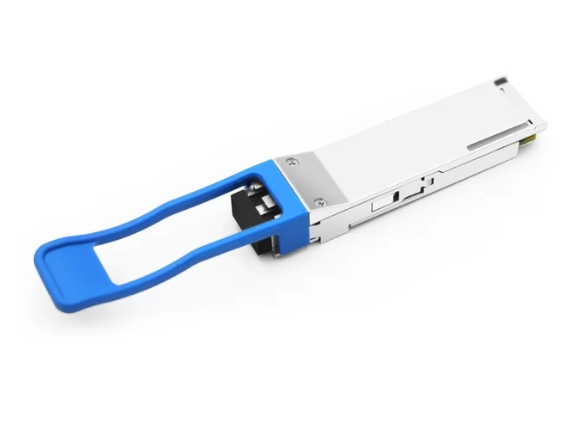
A detailed look at 850nm 150m performance
The Cisco QSFP-40G-SR4 optical transceiver module operates at 850nm wavelength and enables fast data transmission on multimode fiber. It is intended for a maximum 150m distance on OM3 multimode fiber and can go up to 400 meters on OM4 fiber. Key performance metrics are:
- Data Rate: Supports a maximum aggregate data rate of forty gigabits per second.
- Transmitter Output: Consists of four independently operating laser transmitters that emit light at 850nm.
- Receiver Sensitivity: The receiver receives signals with -11.5 dBm sensitivity, which allows for reliable signal processing in difficult conditions.
- Maximum Link Length: Achieves optimal performance within specified distances, dependent on fiber type and quality.
It is these attributes that make it ideal for applications such as high-density, high-performance data centers, and enterprise networks.
Understanding DDM and its benefits
The term Digital Optical Monitoring (DOM) or Digital Diagnostics Monitoring (DDM) refers to the real-time monitoring capability provided by optical transceivers. With this technology, it is possible to obtain important performance metrics including temperature, voltage, laser bias current, and transmitted/received optical power levels. DDM’s major advantages include:
- Better Dependability: Potential issues can be identified early on thus enhancing reliability since transceiver operating parameters are monitored continuously.
- Improved Performance: Network managers can utilize DDM to optimize link performance by analyzing signal quality and fiber health.
- Proactive Maintenance: The ability to track trends in performance over time facilitates proactive maintenance strategies that reduce downtime and increase system life.
- Assistance with Troubleshooting: Immediate access to diagnostic information can help expedite the troubleshooting process thus resolving network-related problems more quickly.
Overall network performance and reliability are improved through the integration of DDM-capable transceivers such as Cisco QSFP-40G-SR4.
Compatibility with various network interfaces
In order to integrate the QSFP-40G-SR4 transceiver seamlessly into existing network infrastructures, it is important that the compatibility of the same with different network interfaces is established as true. This transceiver supports key interfaces, which include:
- 40G Ethernet: It is built on the basis of a 40 Gigabit Ethernet standard thus enabling high-speed data transfer within a data center.
- OTU3: It can also work for Optical Transport Network (OTN) standards, especially OTU3, and hence facilitates transport in environments with high capacity.
- Infiniband QDR: The QSFP-40G-SR4 can be used for Infiniband connections that provide the requisite combination of high bandwidth and low latency necessary for high-performance computing applications.
The multiple protocol support feature of QSFP-40G-SR4 ensures that it can be employed in diverse networking applications, making it suitable for organizations looking to enhance or expand their networks more efficiently.
FAQs About Cisco’s Optical Transceiver Modules
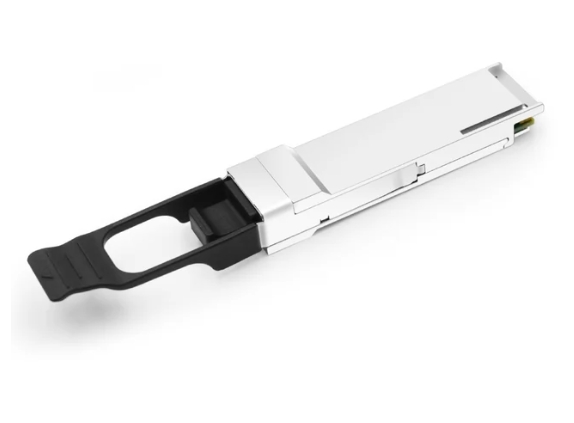
What makes Cisco QSFP 40G unique?
The Cisco QSFP-40G transceiver is a high-density form factor that supports data rates of up to 40 Gbps. It also supports different networking standards. Its unique feature is its ability to transmit over multimode fiber for distances as far as 150 meters and single-mode fiber for distances reaching up to 10 kilometers which makes it flexible in terms of deployment. Moreover, this module has DDM capability that allows real-time monitoring of operational parameters, thus improving reliability and simplifying management in the network. All these features together provide organizations with a strong solution for their high-performance networking requirements.
How do we ensure optimal performance?
For optimal Cisco QSFP-40G transceiver performance, users should take into account the following best practices:
- Proper Installation: Be sure to insert the transceiver in the correct port with attention to its orientation and connector type to avoid damage or connection issues.
- Use Compatible Components: Use cables and networking devices that are compatible with or better than those stipulated for QSFP-40G in order to guarantee data integrity as well as performance.
- Monitor Environmental Conditions: Keep within specified temperature and humidity ranges to avoid too much heat or moisture, which may affect the device’s longevity and performance.
- Regular Firmware Updates: Be aware of firmware updates for your network devices and apply them when needed so as to improve compatibility and performance metrics.
- Implement Link Monitoring: Regularly use digital diagnostic monitoring (DDM) features to evaluate the health of a link, thus enabling proactive maintenance and issue resolution.
By sticking to these guidelines, firms can extend the life span of their Cisco QSFP-40G transceivers leading to increased network efficiency.
Can I use third-party modules with Cisco hardware?
When it comes to using third-party modules with Cisco hardware, there seems to be a lot of confusion about compatibility and support. In general, it is best to use only Cisco-approved transceivers and modules for optimal performance and reliability. Because these components have not been tested by Cisco for compatibility, their use may void warranties or support agreements. However, some organizations choose third-party options as they can be cheaper and offer a wider selection. It’s very important that you check if any such module meets industry standards and certifications before proceeding with its implementation in your network environment. Additionally, this could result in inconsistent performance, which makes troubleshooting difficult later on down the line. All things considered, while functional in certain cases, it is still advisable to rely solely on Cisco-certified parts if you want to ensure maximum network integrity along with access to technical assistance when needed most!
Reference Sources
Frequently Asked Questions (FAQs)
Q: What is the Cisco QSFP 40G transceiver module?
A: A high-speed, high-performance module for data center interconnections and high-throughput computing. It is typically found in switches such as the Cisco Nexus and has a maximum data rate of 40Gbps.
Q: What types of connections does Cisco QSFP 40G support?
A: The Cisco QSFP can support different types of connections, including duplex LC, MPO connectors, and breakout cables for 10G connections. Specific models, like the 40GBase-SR4, are for short distances, while others, like the 40GBase-LR4, support up to long distances.
Q: What is the difference between Cisco QSFP-40G-SR4 and Cisco QSFP-40G-C-SR4?
A: The first one works over multi-mode fiber (MMF) at a distance of up to 150 m using an 850 nm wavelength, whereas the second one provides similar functions but has longer reach capabilities. They both have a data transmission speed of about 40 Gbps.
Q: Are other switches compatible with the Cisco QSFP module
A: Yes, this module was designed specifically for use on various types of networking equipment from different manufacturers, including those within the same brand name, such as the Nexus series, among many others, because it meets SFF standards41 and multisource agreement requirements by QSFP.
Q: Can I use my Cisco QSP modules on gigabit networks?
A: Absolutely! Using breakout cables allows you to split your four separate ten-gigabit connections into two pairs, which can be used interchangeably between twenty GbE ports, which means more flexibility when configuring your network topology.
Q: What are the benefits of using a breakout cable and Cisco QSFP 40G module?
A: A breakout cable with the Cisco QSFP 40G module provides more flexibility and efficiency regarding network setups. The high-speed 40Gbps link can be split into several different 10G connections, which is critical for optimizing infrastructure and networks.
Q: Can you explain how the optical module works for 40GBase-SR4?
A: This particular optical module works through short-distance multimode fiber (MMF), where eight fibers with MPO connectors transmit data over a distance of up to 150m at a wavelength of 850nm. It’s used primarily in data centers and environments that require high-performance computing.
Q: What is the range of coverage offered by Cisco’s LR4 transceiver?
A: Cisco’s 40GBase-LR4 modules can cover distances up to 40 km over single-mode fiber (SMF). Efficient long-distance connectivity options are provided through multiplexing data on four wavelengths, ranging from 1270nm to 1330 nm.
Q: Where can I find information regarding compatible Cisco transceiver modules?
A: You may locate a list containing compatible transceiver modules manufactured by Cisco either on its official website or among authorized vendors selling Cisco products. Some examples include models such as SFP-10G-SR or WSP-Q40GLR4L, which meet specific networking needs.
Q: What should I consider when selecting a Cisco qsfp forty-gigabit module?
A: When choosing any of the multiple models available, such as forty (20gbase-sr4) or forty (20gbase-lr4), you need to consider the required data rate, fiber type (multimode fiber or single-mode fiber ), connection type ( duplex LC, MPO, etc.), distance, and compatibility with existing network equipment.
Related Products:
-
 Cisco QSFP-40G-SR4-S Compatible 40G QSFP+ SR4 850nm 150m MTP/MPO MMF DDM Transceiver Module
$25.00
Cisco QSFP-40G-SR4-S Compatible 40G QSFP+ SR4 850nm 150m MTP/MPO MMF DDM Transceiver Module
$25.00
-
 Cisco QSFP-40G-CSR4 Compatible 40G QSFP+ CSR4 850nm 400m MTP/MPO MMF DDM Transceiver Module
$30.00
Cisco QSFP-40G-CSR4 Compatible 40G QSFP+ CSR4 850nm 400m MTP/MPO MMF DDM Transceiver Module
$30.00
-
 Cisco WSP-Q40GLR4L Compatible 40G QSFP+ LR4L 1310nm (CWDM4) 2km LC SMF DDM Transceiver Module
$129.00
Cisco WSP-Q40GLR4L Compatible 40G QSFP+ LR4L 1310nm (CWDM4) 2km LC SMF DDM Transceiver Module
$129.00
-
 Cisco QSFP-40G-PLRL4 Compatible 40G QSFP+ PLRL4 1310nm 1.4km MTP/MPO SMF DDM Transceiver Module
$139.00
Cisco QSFP-40G-PLRL4 Compatible 40G QSFP+ PLRL4 1310nm 1.4km MTP/MPO SMF DDM Transceiver Module
$139.00
-
 Cisco QSFP-40G-UNIV Compatible 40G QSFP+ UNIV 1310nm 150m/2km LC MMF/SMF DDM Transceiver Module
$149.00
Cisco QSFP-40G-UNIV Compatible 40G QSFP+ UNIV 1310nm 150m/2km LC MMF/SMF DDM Transceiver Module
$149.00
-
 Cisco QSFP-4X10G-LR-S Compatible 40G QSFP+ LR4 1310nm 10km MTP/MPO SMF DDM Transceiver Module
$149.00
Cisco QSFP-4X10G-LR-S Compatible 40G QSFP+ LR4 1310nm 10km MTP/MPO SMF DDM Transceiver Module
$149.00
-
 Cisco QSFP-40G-LR4 Compatible 40G QSFP+ LR4 1310nm CWDM4 10km LC SMF DDM Transceiver Module
$149.00
Cisco QSFP-40G-LR4 Compatible 40G QSFP+ LR4 1310nm CWDM4 10km LC SMF DDM Transceiver Module
$149.00
-
 Cisco QSFP-40G-BD-RX Compatible 40G QSFP+ SR Bi-Directional 850nm/900nm 100m/150m Duplex LC MMF Optic Module Receiver Only
$165.00
Cisco QSFP-40G-BD-RX Compatible 40G QSFP+ SR Bi-Directional 850nm/900nm 100m/150m Duplex LC MMF Optic Module Receiver Only
$165.00
-
 Cisco QSFP-40G-LR4-20 Compatible 40G QSFP+ LR4 1310nm CWDM4 20km LC SMF DDM Transceiver Module
$175.00
Cisco QSFP-40G-LR4-20 Compatible 40G QSFP+ LR4 1310nm CWDM4 20km LC SMF DDM Transceiver Module
$175.00
-
 Cisco QSFP-40G-SR-BD Compatible 40G QSFP+ SR Bi-Directional 850nm/900nm 100m/150m Duplex LC MMF Transceiver Module
$249.00
Cisco QSFP-40G-SR-BD Compatible 40G QSFP+ SR Bi-Directional 850nm/900nm 100m/150m Duplex LC MMF Transceiver Module
$249.00
-
 Cisco QSFP-40G-ER4 Compatible 40G QSFP+ ER4 1310nm (CWDM4) 40km LC SMF DDM Transceiver Module
$449.00
Cisco QSFP-40G-ER4 Compatible 40G QSFP+ ER4 1310nm (CWDM4) 40km LC SMF DDM Transceiver Module
$449.00
-
 Cisco Compatible 40G QSFP+ ZR4 Lite CWDM4 60km LC SMF DDM Optical Transceiver Module
$599.00
Cisco Compatible 40G QSFP+ ZR4 Lite CWDM4 60km LC SMF DDM Optical Transceiver Module
$599.00

